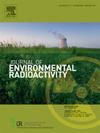Numerical simulation study on radon migration in roadway surrounding rock under heat- moisture -force coupling
IF 2.1
3区 环境科学与生态学
Q3 ENVIRONMENTAL SCIENCES
引用次数: 0
Abstract
With the increasing demand for uranium resource development and the gradual deepening of mining, radon pollution has become a significant issue in underground mines. This study aims to investigate the effects of temperature, humidity, ventilation pressure, and rock stress on radon migration in roadway surrounding rocks using Computational Fluid Dynamics (CFD) combined with a heat-moisture-force coupling model. The results show that the pressure difference on the roadway wall is positively correlated with the radon exhalation rate, while an increase in inlet air speed leads to a decrease in the exhalation rate. Among environmental factors, temperature exhibits a more pronounced impact on radon exhalation rate compared to humidity, especially due to stress and temperature changes after roadway excavation. The study also reveals that deepening the roadway and increasing surrounding rock temperature and stress further enhance radon exhalation. These findings highlight the critical role of ventilation and environmental factors in controlling radon concentrations in underground spaces, providing a theoretical foundation for future research on radon migration in deep underground environments.
热-湿-力耦合作用下巷道围岩氡运移的数值模拟研究
随着铀矿资源开发需求的不断增加和矿山开采的逐步深入,氡污染已成为地下矿山的重要问题。利用计算流体力学(CFD)结合热-湿-力耦合模型,研究温度、湿度、通风压力和岩石应力对巷道围岩氡迁移的影响。结果表明:巷道壁面压差与氡呼出率呈正相关,入口风速增大导致氡呼出率减小;在环境因素中,温度对氡析出率的影响比湿度更明显,特别是巷道开挖后应力和温度的变化。巷道的加深和围岩温度和应力的增加进一步促进了氡的释放。这些发现突出了通风和环境因素在地下空间氡浓度控制中的关键作用,为进一步研究深部地下环境中氡迁移提供了理论基础。
本文章由计算机程序翻译,如有差异,请以英文原文为准。
求助全文
约1分钟内获得全文
求助全文
来源期刊

Journal of environmental radioactivity
环境科学-环境科学
CiteScore
4.70
自引率
13.00%
发文量
209
审稿时长
73 days
期刊介绍:
The Journal of Environmental Radioactivity provides a coherent international forum for publication of original research or review papers on any aspect of the occurrence of radioactivity in natural systems.
Relevant subject areas range from applications of environmental radionuclides as mechanistic or timescale tracers of natural processes to assessments of the radioecological or radiological effects of ambient radioactivity. Papers deal with naturally occurring nuclides or with those created and released by man through nuclear weapons manufacture and testing, energy production, fuel-cycle technology, etc. Reports on radioactivity in the oceans, sediments, rivers, lakes, groundwaters, soils, atmosphere and all divisions of the biosphere are welcomed, but these should not simply be of a monitoring nature unless the data are particularly innovative.
 求助内容:
求助内容: 应助结果提醒方式:
应助结果提醒方式:


